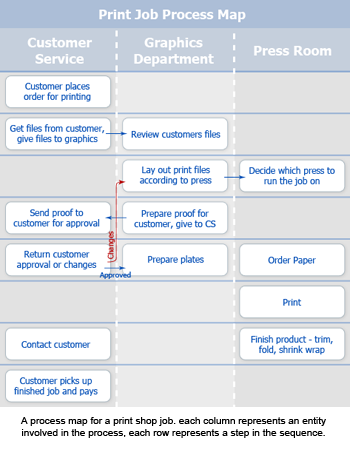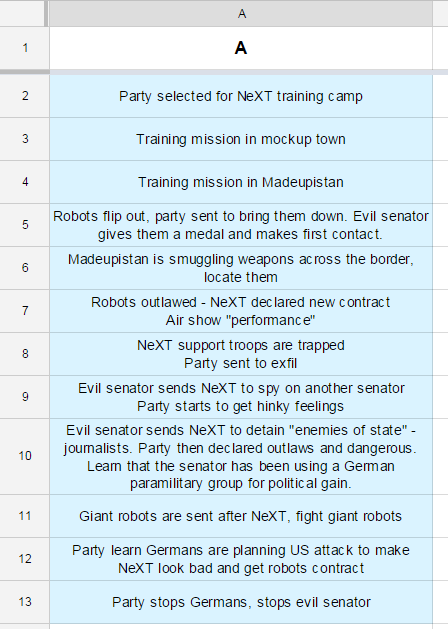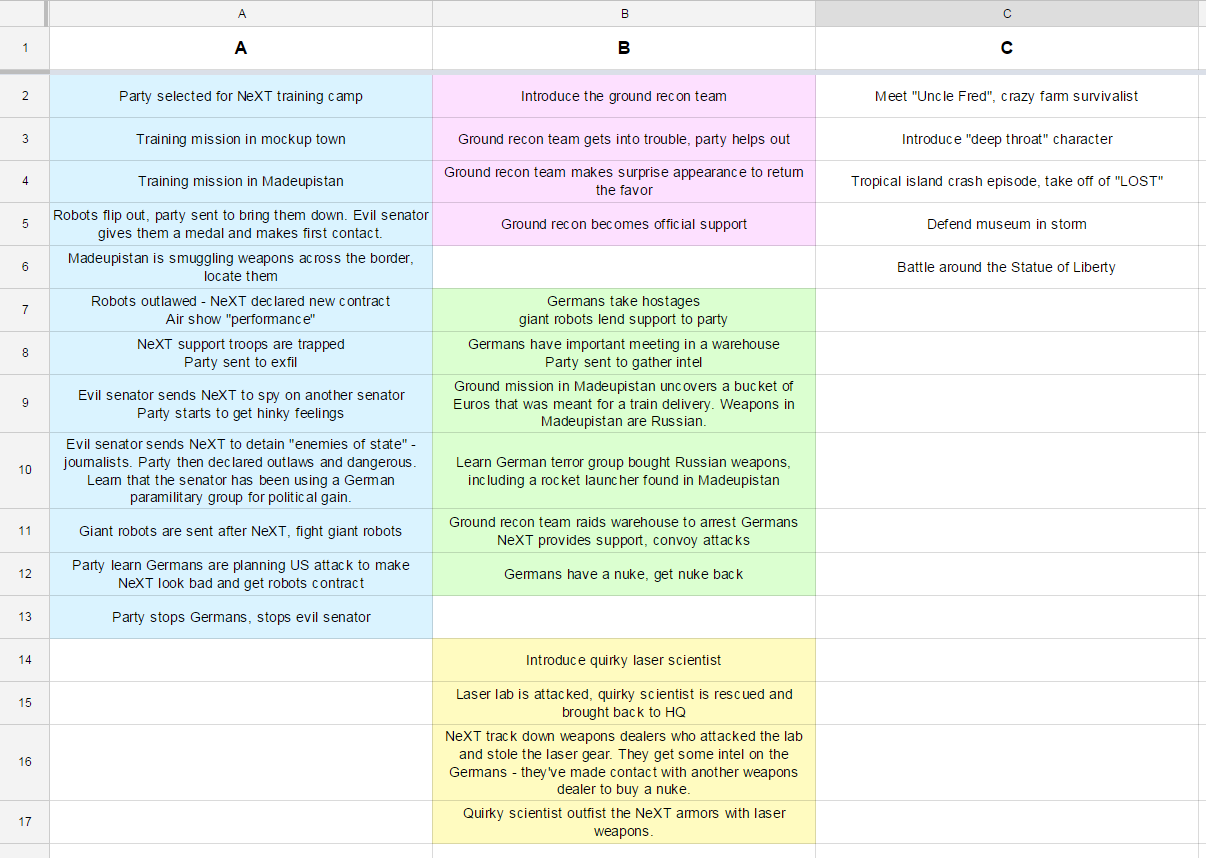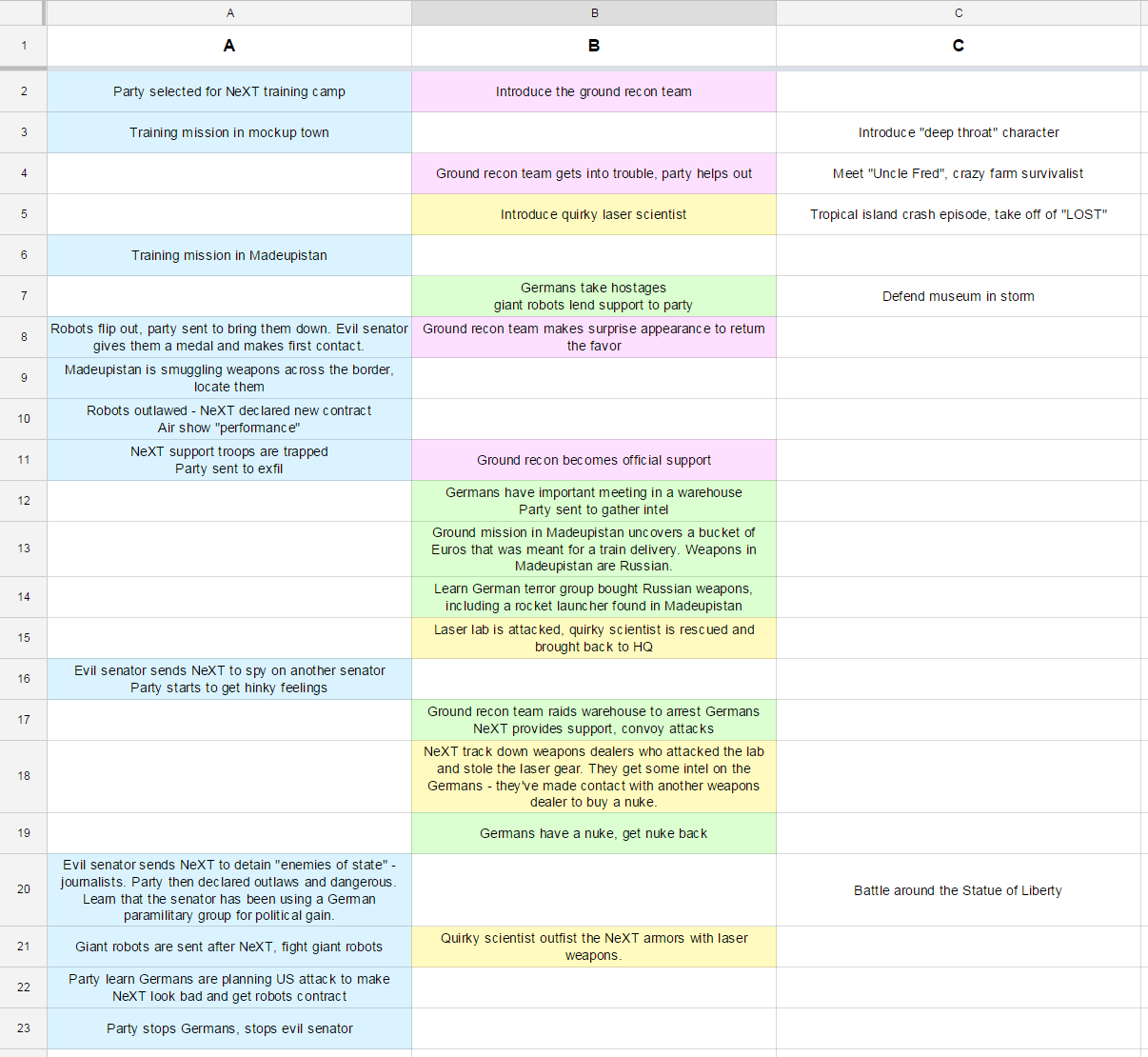One of my players has been working on learning to GM and has been asking me questions about my writing processes.
I'll be honest, my processes are few - there's not much to my GM'ing beyond "tell a good story". The way I run my games varies pretty widely depending on the group, system and setting.
But on the other hand, I'm not the type of GM who believes every game should be run 100% on-the-fly. The last thing I want to do is sit at a table while the players are looking at me waiting for some kind of prompt for something to happen. It's far less stressful for me to adapt a story to the players than to improvise a story as we go.
The main story technique in my GM bag of tricks, which I've used to write some of my best campaigns, is to write the story as a process map. I use it every time I write a longer campaign of a dozen or more sessions where the story has to have a meaning (If I'm free-wheeling a sandbox campaign, I usually just make up the next adventure after each session). Having a plot beats map lets me pace the reveals in my story while still being completely open to improvise based on the player characters.
Here's how I do it.
Images are zoomable.
Before we begin, let me explain that this technique is not about railroading, it is the opposite of railroading. Prepping a story this way forces you to surrender a good deal of creative control to the players. You must incorporate player discoveries, expectations and character personalities into your plots if you write this way because it's all about beats and not "plot". Your work will be more about organizing events in a story than actual writing of the story. That probably doesn't make much sense, but I think you'll get it before I'm done. Just understand that this only works if you're willing to follow your players' lead with the story.
What is Process Mapping?
You've probably seen character nodal charts. This is a creative writing technique where each node on a flowchart represents a place or character, and the connecting lines explain how they're related. It's great for understanding the characters and their relationships but it does fuck-all for building a story.
A process map, however, is an actual, literal timeline. The structure we're going to be using is called a Deployment Flowchart, if you're tickled by that sort of thing. It's sometimes also referred to as a Swim Lane Chart. Really, it's just a timeline.
Each column of the process map represents one entity involved in a process, each row is a node in time where an event or group of events happen. You can see at a glance where each entity is at any node of the process, even entities not involved in that node.
The sample process map to the right shows the steps in getting a print order done at a print shop. It shows where each department in the shop is involved and what they're doing at each step. (Process maps typically run left-to-right, but for our purposes I'll be running top-down because I'll be using a spreadsheet).
In story terms, a process map lets you see everything that's happening at any point in the story, even events occurring in the background.
Building a New Campaign
I always start my campaigns with some rough, longhand world building. I begin by free-associating everything I can come up with based whatever idea spark it was that I started with. I write down everything, no matter how silly or unlikely to appear in the game. Scenes, adventure ideas, funny/interesting characters - If it sounds cool, it goes in.
I'll use this list to answer some questions about the flavor of adventuring in this setting -
What technology do adventurers have available to them?
What does that technology mean in terms of adventuring?
What are the ruling powers and what do they mean to an adventuring party?
What does the world smell like? Taste like? Sound like?
What makes this game world fun and interesting?
What style of adventures best fit this game world?
The answers to these questions help me iron out the setting's concept. When I'm done scribbling notes and answering questions, I'll have a decent idea of what I can accomplish in terms of story.
This is the point at which I'll go to my players and pitch my idea. I'll give everyone a rough overview of my ideas for the setting and what kind of characters I imagine them playing. If the players seem interested, I’ll try to find out what sort of expectations they have for that game based on their first impressions. Most likely, I'll draw up a Fear the Boot-style campaign template so I have their expectations handy for later reference. What I really want is to make sure we're all expecting the same kind of game, but I'm also using the opportunity to mine the players' ideas for things I might not have considered when doing my free-form noodling.
Creating the A Story
Now I switch to digital and start writing the beats of the A story.
(I'll be using a few writing terms - such as "A Story" and "beats" - in this article. If you're familiar with them, great, but if you're not don't sweat it. I'll make sure to explain everything as we go.)
The A Story is the main plot of the game; it'll be what the players think of when asked what the game is "about". Typically, the A story looks like this - a bad thing is coming, the heroes get involved, they scrap with the bad, the heroes overcome. You can do the classic dramatic structure or monomyth if you want, but it's really not necessary in a gaming campaign. The kind of character growth that a literary structure anticipates only happens to role-playing characters through player investment and you can't plan that. You're better off keeping simple.
A "Beat" is just a step in the story, an action, event or revelation that becomes the characters' next point of progress through the story. I can get all Creative Writing 101 here, but you don't need it. Just think of your beats as the major events of your story - a fact is learned, a fight happens, an NPC is met, etc.
So I'm going to go back to my scribbled list of notes and pick out the story ideas. Then I'm going to add them to the player contributions and try to come up with 12-15 major events for my main story line. Again, I'm keeping it simple - no monomyth jargon here. I want the most basic progression from introduction to climax, all in noun-verb-subject sentences.
“The gang acquires a nuke”
“The volcano erupts”
“The orcs kidnap the king”
Once I've got a list of events, I put them in chronological order and polish them up a bit.
For my sample story, I've chosen as my concept, the central idea of the story, "NeXT battle armors", a complete and utter ripoff of the Centurions toys from the 80s. All of the A Story events spin off from that concept and what that concept means to the party - they are chosen for the NeXT program, they do some training excercises, some villains show up for them to hate, intrigue happens, the true villain is revealed for the end of the story.
One thing to note is that where events in my beats directly involve the party, I try to limit them as much as possible to things that are done to the party, as opposed to things the party does. "Bad guy mocks party" is something I can count on, "party mocks bad guy" not so much.
B & C Stories
Now I've got my A story. I can run it as is. And if I wanted a quick, throw-together campaign with little character development, I would. But this is bland. I'm going to make it more interesting by introducing a couple B stories.
B story is what happens alongside the A story. It usually involves interesting NPCs or exotic locations that aren't necessarily part of the A story, but that provide information and tools that give the characters a leg up in the A Story. B story plots should always leave the PCs with a new tool or bit of information that benefits the party, even if they don't immediately realize it.
B stories are short. If my campaign is 12-15 beats, I'll usually include two or three B stories of 3-6 beats each.
In our example campaign, I've included three B stories that all involve the party gaining extra resources - a support crew they can trust, a gadget scientist to improve their gear where necessary, a pile of incendiary evidence about the Senator's wrongdoing that will only make sense when they uncover said wrongdoing.
So what are C stories? When you go back to your notes, you'll often find story ideas that you think are fun or interesting but that don't relate to the main story. You might have a story idea that's outside the game concept's genre, or maybe there's a character-driven idea prompted by a player. These are C stories.
C stories should be a single beat on your chart, and the number of C stories you use should depend on how actionable your A story beats are; the more the A story requires of the party, the fewer C stories you should have. What I mean is - if my campaign were mostly investigation with an A story told primarily through reveals, I would move the action to the C column with a whole series of one-shot C story adventures for the party to have while the A story builds. On the other hand, if the A story is mostly action - our sample campaign for example has the party mostly moving from mission to mission - then I'll include very few C stories and they'll mostly be light-hearted breaks from the A story action.
Back to our sample campaign - as I noted, the A story builds over a series of actionable beats that involve a lot of combat missions. The C stories end up being a handful of one-offs where I introduce funny characters or maybe put the party through a haunted museum adventure that doesn't fit the genre of the concept.
Putting it All Together - or How I Learned to Stop Worrying and Throw Out the 3 Act Structure
Ok, you've followed along, and now we've got all of our story beats in my spreadsheet ordered chronologically. The next step is to spread out the stories in an interesting way.
Start by putting the B story beats in the order they should run, regardless of which B story they're a part of. You may want your B stories to run in direct sequence, one after the other, but the actual beats might not work in that way - a beat from the second B story might need to occur before the first B story is over. It's also far more interesting, storywise, to "feather" the borders of your stories a little so there's not as much delineation between them. You'll also want to arrange your stories so that as many introductions as possible happen early in the campaign - you don't want to introduce a recurring character too late in the game.
Next, spread your beats out so that each row contains only events that can happen simultaneously. Imagine that each row represents one gaming session (it probably won't, but we'll get to that) the events at that stage will all happen in that same session.
To keep my games from getting choked with story, I've developed a 2-beat rule - no stage of the campaign can have more than 2 beats on it from any column. When I choose which beats go together, I decide which will be the main focus of the session, and then choose a B or C story beat that either compliments that main event or that can be logically introduced while that main event is occurring. If I can't find two beats that line up well, or when I come upon an event that probably needs a lot of room to be dealt with properly, I'll have a stage with only one beat on it.
This step is more art than science. Trust your instincts here and decide what feels best for your games. As you get better with thinking in beats, you'll get better at knowing which beats go together.
Now we're ready to game.
Running This Game - aka The D Column
We're done.
Sort of.
No, you couldn't sit down and run what you have as it is, which is actually the point. But you are prepared to write an opening.
Think of your campaign opening as the first few episodes of a new TV series - we have a good idea of the setting, and the flavor is there, but the actors haven't all fallen into their characters just yet. You'll need to come up with 3 or 4 basic "get to know you" adventures. These are simple, flimsy things that require nothing more than the most basic problem solving. We don't need story complexity here because our story isn't complex yet.
But as you near the end of these introductory adventures, you'll have a pretty solid idea of how the players are playing their characters and how they're approaching the campaign world. You'll be able to see their capabilities and preferences - do the players enjoy remote missions or do they prefer to stay around HQ? Are they digging on sneaky prowly missions or do they have a preference for combat fighty ones? Is the party full of gruff and brash heroes or a band of smart-asses with guns?
As you finish up with the introduction adventures, and as you continue playing through the campaign, you can come up with each week's adventure fairly quickly by taking the next stage of your flowchart and figuring out what the past events of the campaign mean to those story events. That's right, you're leaving the actual adventure writing to be done as the campaign plays.
And this is where the D column comes in.
Yes, there's a D column. Of course there's a D column.
D column beats are either based on player character actions or they're followups to emergent events from past game sessions. If a player drops a bit of interesting character backstory, or character story happens as part of the order of play, you might want to bring that flavor into the campaign by adding D column beats for it further down the timeline. D column beats are malleable - you can move them, rewrite them, or ignore them as story necessity dictates. Just make sure you keep adding them so that you have them. Anything interesting that grows organically out of actual game play should end up on the D list so you can come back around to it.
And, yes, when I'm running out my campaigns, the D column beats can violate my 2-beat rule, but only if that works for the story.
Regarding Length
Our example campaign ended up being about 25 sessions long. And if you follow the steps I gave above - a 12-15 beat A story and three 3-6 beat B stories - you'll end up with a campaign just about that length. For my group, that's a short campaign; it might not be for your group.
If you want a campaign much shorter than that, process mapping might be more than you need in order to accomplish your goal. You can certainly derive benefit from mapping an 8-beat A story and one B story, but you probably don't need to if you can probably keep everything straight in your head or penciled into a notebook.
If you want a campaign that's longer than our sample, I would recommend adding more beats to the A and B stories rather than adding more stories. An A story can be padded out to 15-20 beats and still be pretty playable, and you can stretch a B story out to about 10 beats before they become their own campaign arcs. You can also add as many stand-alone C story adventures as the players will tolerate, especially if you're running a more sand-boxy game world.
If you're still looking for an even longer campaign, you might want to consider a series of separate campaigns. End one A story, and its accompanying B stories, and then start another.
Final Wordy Bits
You might already see the value I find in a process map style of design, but I’ll put it out bluntly anyway.
Writing this way frees me from worrying about whether the party will do the “correct” thing to get from point to point in the story. I don't care how they go about working their characters - well I do, but only in so much as I care about things like not wanting players to be jerks to each other. The story I've written doesn't rely on the players, but it's also purposefully designed to incorporate player input.
The prepared beat charts may not rely on character actions for the story to play out, but that does not mean character actions aren't important. Just the opposite is true. Character choices are more meaningful because when I read a story beat, I literally don't know exactly how it'll happen until the players get me there. I am following the players' lead on how the story unfolds. When I write each week's session, what the party have already done determines how the next stage occurs. That means, for me, the next part of the story is always a surprise.
It's half pre-writing the campaign, half improvising and I find it's the best of both styles. It's pre-provising. Or impro-writing. Or something.
If I took the chart for a campaign and ran it with two different groups, I'd end up with two vastly different campaigns.
One last thing - there's a reason I work digital for my timelines and that's because I can cut and paste on the fly. I can add to the timeline with D story callbacks, but I can also directly edit the main stories at any time. Part of my session prep for a campaign will be flipping through the upcoming story beats and looking for ways to sharpen the story based on the previous sessions. If I see a better way to introduce a beat, I make changes. If I think a beat will work better in a different order, I move it. If I see a beat or B story that's not going to fit - either because a previous session failed to set it up properly or because the players just weren't interested in it when it was set up - I'm going to remove it.
Process Mapping a story might be a goofy way to write campaigns, but it really works for me and I think it's made me a better storyteller. It's definitely made me more collaborative with my games without sacrificing any of my trad-GM sensibilities.
Hopefully, you've picked up at least one idea from my method to make your process better.






